There are three main ways to propagate strawberry plants. The plants can be divided and transplanted once multiple crowns have been grown (or division of rhizomes), new plants can be grown from strawberry seeds, or the runners that strawberry plants put out can be controlled, guided, and caused to root where clone plants can be utilized most efficiently.
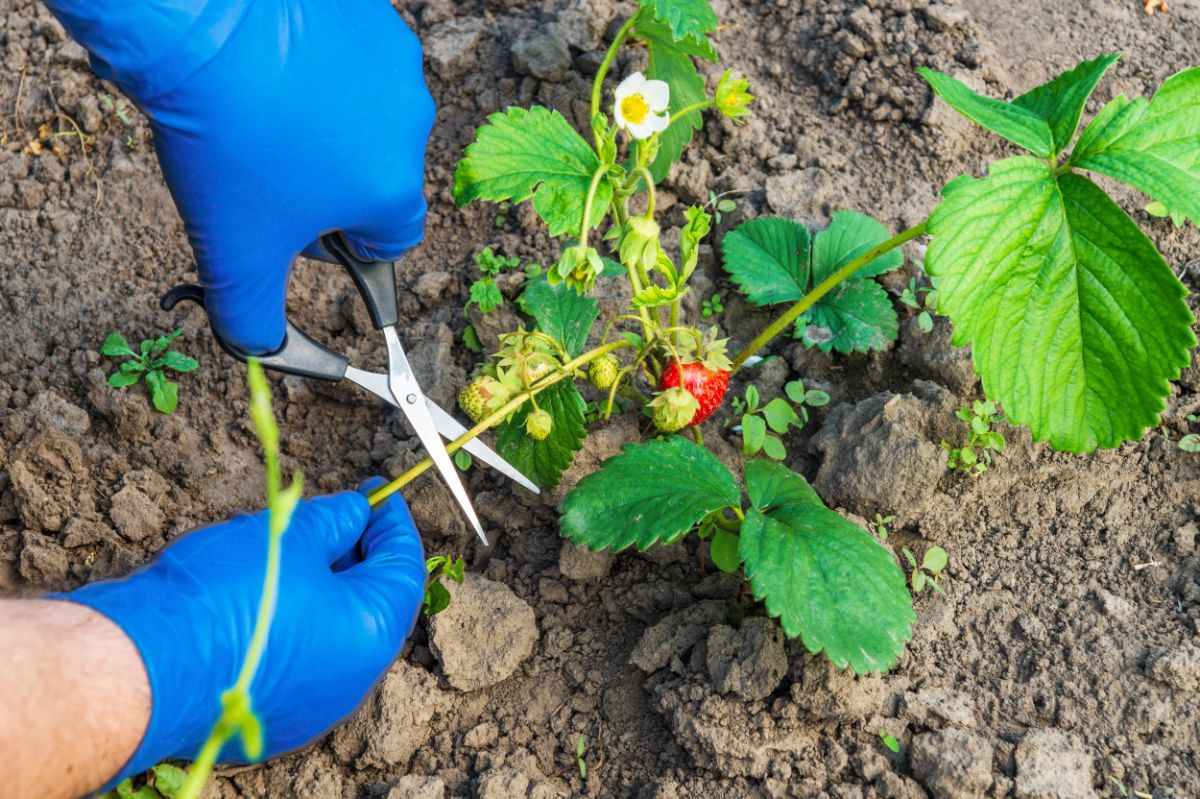
There are positives and negatives about propagating strawberries with each method, all of which will be briefly discussed. However, to offer the bottom line up front, most gardeners will find that the easiest way is to propagate strawberry plants by runner.
Jump to:
Strawberry Propagation by Plant Division
Many types of strawberry plants will, either by nature or if encouraged by pruning runners, put out lateral crowns at the base of the strawberry plant. The crown of the strawberry plant is a short, thick stem that has a growing point slightly (maybe one-quarter of an inch, less than a centimeter) above the surface of the ground and a thick mass of roots growing down into the soil. These lateral crowns can be divided and replanted to propagate strawberry plants. Additionally, the genetically generative rhizomes of strawberry plants can, under the right circumstances, be divided into multiple pieces with each piece being sufficient to grow a new plant.
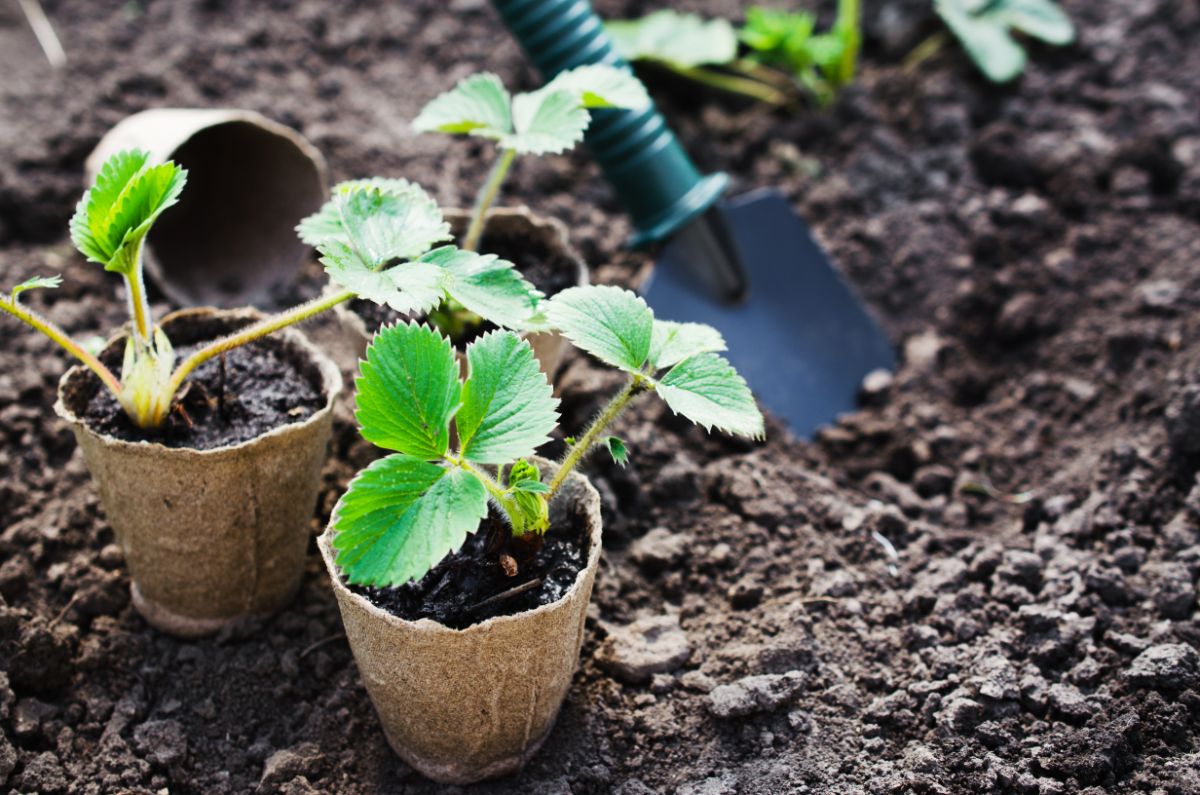
There are, however, several drawbacks to this type of strawberry propagation. Often, the mother plant will be compromised (if not done correctly) and will die. Thus, the net increase of strawberry plants is diminished. Also, it tends to be more labor-intensive and technical as the division or cutting takes both precision and a bit of expertise. However, for well-funded or commercial operations, this division can be used to propagate cloned plants quickly and extensively.
Step-by-step procedure for dividing strawberry crowns
The only time of year to divide strawberry crowns is early spring, when the weather is cool and moist.
Water the plant you intend to divide the night before to soften the soil and hydrate its roots. You need to water the soil to a depth of about six inches (15 cm).
The base of the plant should be clearly visible above the soil. Tie the stems together with a piece of string to keep them out of the way when you cut the crown.
Scratch a circle in the soil around the plant 2 to 3 inches (5 to 8 cm) away from the crown. You will use this as a guide for digging.
Dig down to a six-inch (15 cm) depth with a clean, sharp garden trowel. Use the blade of the trowel to work underneath the root ball of the strawberry plant. Pry the plant out of the soil. Lift out the strawberry plant and fill in the hole left in your strawberry bed.
Untie the strawberry stems. Cut down through the center of the root ball to create two strawberry plants of approximately equal size. Gently brush enough soil off each half of the root ball to expose the roots.
Subdivide each half of the root ball into smaller plants, each with 6 to 12 healthy roots and its own crown of at least half an inch (a little over a centimeter) diameters. Don’t divide small crowns, because they may not survive long enough to put out their own roots.
Dig a hole from planting each part you divide from the original strawberry plant. Make the hole just a little deeper than the root ball so the crown is at least one-quarter inch (a little less than a centimeter) to one-half inch (a little less than 1.5 centimeters) below the level of the soil. Put the roots into the hole you dug and press soil around them. Loosely cover the crown with soil, leaving stems and foliage exposed.
You will need to keep your new strawberry plants well-watered during their first season as they are putting out new roots. Protect each crown with a 2-inch (5-centimeter) layer of loose mulch to protect it from fluctuations in temperature and humidity. You should see new leaves in a few months and flowers and fruit next year.
Strawberry Propagation by Planting Strawberry Seeds
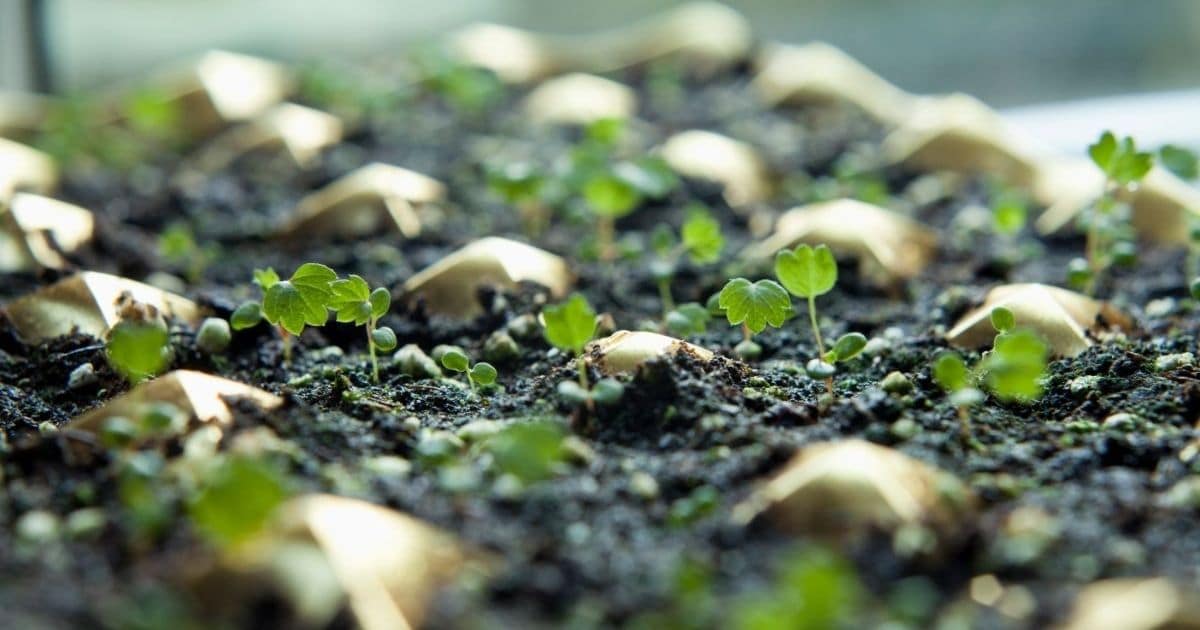
Visit the Strawberry Seeds page for the details on how to plant and start strawberry seeds and the Growing Strawberries page for help propagating strawberry plants by nurturing the seedlings into viable, mature strawberry plants.
Growing strawberries from seeds has the potential for vast numbers of new strawberry plants to be grown. Each strawberry has approximately 200 seeds adorning its outer surface. While unusual for every seed to be viable, that is still a lot of new plants from a single strawberry. Starting strawberry seeds will require most of the standard seed-starting equipment to be used. And, while starting strawberry seeds often requires a few more considerations than does starting common garden vegetables from seeds, it is not overly difficult.
The major drawback of strawberry propagation by seed is the nature of today’s common strawberry cultivars (visit the Strawberry Plant page for the history). Once the Garden Strawberry (Fragaria x ananassa) became the dominant strawberry grown in both home gardens and commercial operations, the seeds became unreliable due to the crossbreeding used to obtain the improved strawberry varieties. This means that attempting to grow strawberry plants from seeds that were collected from a purchased strawberry will likely not produce true plants. In other words, the plants grown from seed will be different from the plant that produced the seeds (sometimes substantially so). The seed-propagated strawberry plants will exhibit genetic traits of the grandparent plants instead of the desired parent plant. The wild strawberry species are an exception to this and will produce plants true-to-form. However, their fruits are much smaller, in general, and not recognized by most as the “strawberries” that are commonly bought and consumed today.
Strawberry Propagation by Runners
Growing strawberry plants from a runner is, for most, the easiest and quickest way to propagate strawberries. Most of the June-bearing, everbearing, and day-neutral varieties produce runners. Some of the wild strawberry varieties do not and must be propagated by seed. But, in general, if someone buys a strawberry plant, it will produce at least a few runners.
The strawberry runners are stolons. These horizontal stems are sent outward from the base of the strawberry plants. At variable distances new strawberry plants will form (at nodes). This is possible because of a strawberry plant’s ability to form adventitious roots. These specialized roots are formed at the nodes along a runner. Wherever these roots touch nutritious soil, they will continue to grow into that soil and establish a new clone plant that is genetically identical to the plant that originally sent forth the runner.
Due to this aspect of runners, it is relatively easy to propagate strawberry plants using them. The long, flexible intermodal parts of the runners allows them to be bent and positioned according to the desire of the gardener. To collect new clone strawberry plants, all one has to do is direct the runners so that the adventitious roots will grow down into a separate, moveable container.
Any small container or pot properly filled with a sandy loam soil will work. It can be buried so that the strawberry plant runner will stay at ground level, or the pot/container can be placed on top of the ground so that it is more easily removed once the new strawberry plant is well-rooted and established. Either way, the runner can be held in place by clothespins, rocks, a pile of dirt, a couple of sticks, or anything else suitable for keeping the runner in position and the node portion in contact with the soil.
Once the adventitious root has established the new clone plant, separate the new plant from the mother strawberry plant by snipping the runner. If it has been established for a while, the runners will eventually shrivel and snap on their own. But, as long as the new plant is well-rooted, no growth will be hindered by snipping or snapping the runners.
Voila! You now have a new, transportable strawberry plant that you can sell, use to start a new strawberry bed, or use in some other imaginative way!
How to Transplant Rooted Runners for New Production
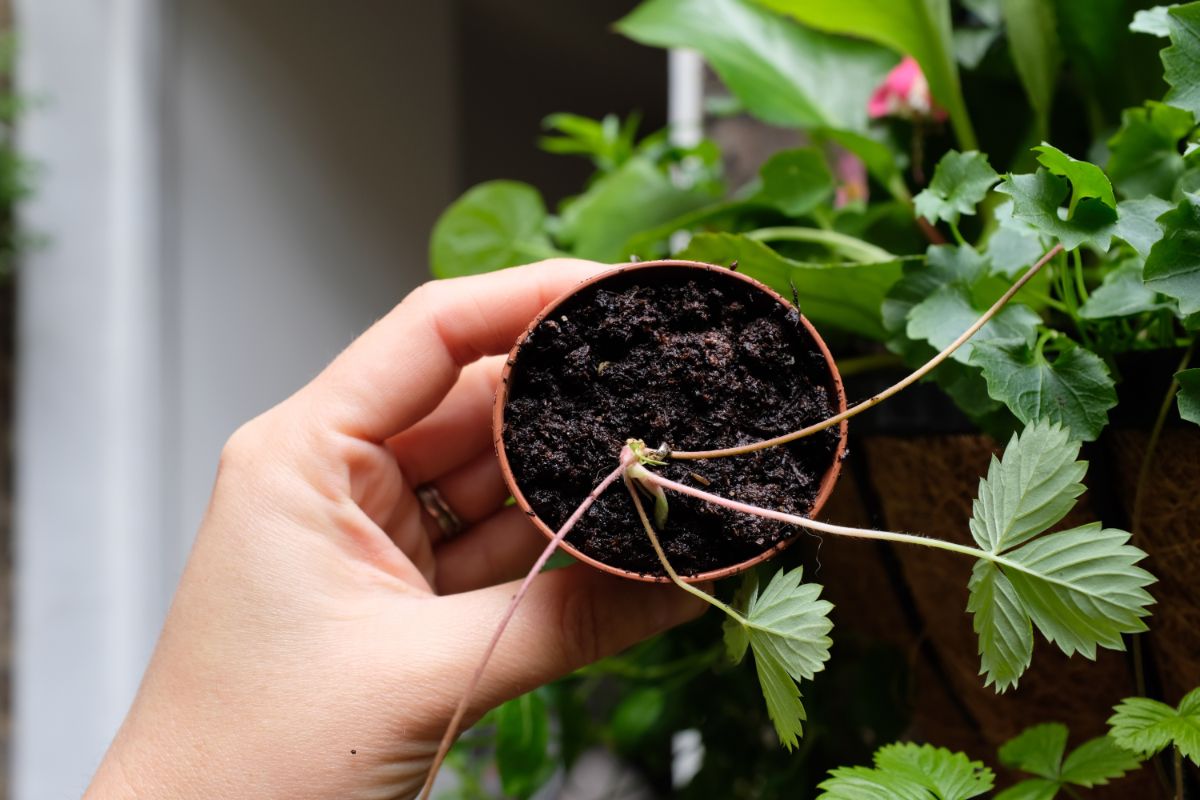
If you have been careful about fertilizing and watering and protecting your strawberry plants from disease, your strawberry bed will tend to become overgrown. It can take some effort to determine which plants are older, producing plants, and which plants are rooted runners.
But you can look at each plant carefully and determine which smaller plants are connected to larger plants. It’s the smaller plants that you will want to disconnect and transplant.
When you find a smaller plant with roots in the ground that is still attached to its mother plant, pull it up gently. Cut the runner to the mother plant as close to the main stem of the daughter plant as possible.
Even if a runner plant looks like it is ready to grow, it is not as well established as its mother plant. It’s just been ripped out of the ground, so it will be undergoing stress.
Your transplants will need to be protected from drying out and excessive heat, and put into new ground as soon as possible. Then they need to be mulched to make sure that they are protected from frost and severe cold and to keep the moisture in the ground around them stable.
Strawberry Plant Propagation: Conclusion
For a new gardener, strawberry propagation by runner is usually the easiest and most successful means of acquiring new plants from existing ones. But, don’t hesitate to try the others if up to the challenge. Also, not all strawberry plants produce the same amount of runners. Check the Strawberry Varieties page for more details on specific cultivars, and, once you find one you like, you can find a supplier by using the Strawberry Plants for Sale page.


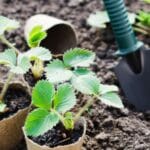



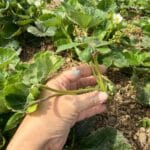
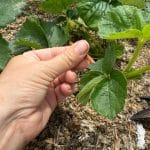

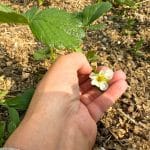
Alyssa says
Is it normal for the runners to start wilting slightly after transplanting them? I took a couple cuttings from runners that had baby roots coming off them and planted them in fluffy potting soil meant for seedlings. A couple hours later they’re all droopy looking. The soil is wet right now because I made sure to give it a good soaking. I know about transplant shock but they look pretty sad right now. Should they perk up?
Mrs D Ogier says
I mistakenly cut the runners off the plants when putting them in pots – I want to know what I can do to save the young runner plants, as they have no help from the parent plant. Can I encourage root growth by keeping them in water for a couple of weeks with maybe some rooting powder dissolved in the water?
Calvin says
If they have roots, put them in a potting mix or compost medium and keep the soil a little moist and give them a little TLC until they root out. If they have no roots and the node is bare(usually strawberry runners have tiny yellow roots that emerge from the nodes after some time), then I’m afraid they are toast and you should throw them in the compost bin. In order for a strawberry runner to create its initial group of roots, it needs that umbilical connection with the mother plant. Once roots are down, however small, there is a chance the plant can establish itself.
Just a side note. As I transplant my runners, I find an occasional runner where it has an abundant amount of leaves/plant material etc, but has not rooted at all. It breaks my heart, but those usually get tossed in the compost bin.
Lori says
Oh, my gosh–I just learned a new thing! Thank you! Here in Spokane, WA, USA, I always have tons of tree leaves and have been grateful for the free winter mulch. I have always had great success growing strawberries, but our summers are lasting well into fall now (with the berries keep going!), and winters are becoming milder. The leaves do not have time to really break down over winter and it is warmer earlier in spring. So I have begun to notice an awful lot of sliminess on the soil and slower spring growth on my everbearing plants. Now I think the leaves are just not good for them–I always did think it was funny that I would lose a lot of the leaf mulch in early winter winds, then the plants would sit kinda bare under the snows, and I would worry about how they were doing. But each spring and set to making berries and runners like nobody’s business. And, of course, the light leaf mulch had broken down into freeze dried tiny bits. So, even though my plants are–it is mid-June–making berries nicely now–I am going to use newspaper, I think, this winter, and see if I can get back to more vigorous, larger plants, and more runners next spring. Great tip.
Sandra says
Hi I have read most of the above but it doesnt give me quite the answer I am looking for. I have existing plants which I think are 2 years old and they are producing runners. I understand what needs to be done regarding these but what do I need to do to my existing plants after removing dead leaves or weak plants etc.
I had a brilliant crop of strawberries in December (New Zealand) and would like to try and achieve the same this summer. To keep my existing plants maintained I guess I fertilise but do I need to put straw under them to keep the leaves off the ground? Is there anything else I need to do?
Sandra
JennNOLA says
Every three years in early October (in Louisiana), I remove all plants from their large container (raised bed) and replenish the soil with a little more potting soil or peat/perlite mix. I add a bag or two of compost (about 1/3 of the new volume) and mix thoroughly. I shake off each plant, cutting any runners if the baby plants are established with their own roots. After planting, I put leaf mulch or cypress mulch between them. I don’t have to cover them because the plants easily survive our winters (light to moderate freezes) in a state of dormancy. As soon as the days lengthen, the plants green up. My Eversweet strawberries had blooms on them on December 29th. I should have strawberries by January 28th!
bose says
Hello, could please let me know the home made nutrient solution for growing strawberries within the soil and without the soil (hydroponics nutrient solution) please
George says
I have a wild variety of strawberry that does not put out runners. It does have a number of rhizome crowns that I would like to separate.
Just wondering what season would be best to perform this delicate and risky procedure. I am in zone 8b Vancouver, Canada. It is near the
end of growing season for us although this ever bearing plant is generously still offering small tasty berries. Also
would mulching over the whole plant during fall / winter be the correct way to protect it ? Thanks for any advice.
Mr. Strawberry says
George,
Right now through the end of October is actually a great time to divide and re-plant the additional rhizomes. I’d point you to this for overwintering advice. Good luck!
Jeff says
I live in zone 5B. What do I need to do to protect the strawberries over winter? Both them and the pineberries both starting sprouting runnings all over the place and i’m finally starting to fill my raised garden bed. Thanks for your help.
Mr. Strawberry says
Jeff,
This should help! Good luck!
Martina says
If I propagate from runners, but I don’t want to plant the new plants until spring, what is the best way to overwinter them? Will they be fine in their little pots in an unheated greenhouse (zone 7) over the winter?
Mr. Strawberry says
Martina,
As long as they are in pots and watered enough to keep the soil from drying out, they will likely do just fine in Zone 7. Good luck!
Khalida zahid says
Hi
2. Yesterday I noticed few holes in the strawberry leaves. Would like to know what treatment I can give to the leaves.
Mr. Strawberry says
Khalida zahid,
Nothing will remedy the damage done to the leaves. However, some insect probably made the holes. You can try diatomaceous earth as a remedy. Good luck!
Brenda says
I planted a new raised strawberry bed last summer. The plants put out runners and filled the bed. Everything looked great. However, during the winter mice got into the bed and made tunnels and ate the roots of many plants and runners. Also, the soil settled quite a bit. I had a very small crop of berries this summer. I need to add more soil to the bed and I think I should transplant some of the plants to other parts of the bed. Any recommendations on when to do this or other tips?
Mr. Strawberry says
Brenda,
I’d recommend working through each section here. See especially the link on transplanting! Good luck!
biyu says
i planted some eversweet and pineberry strawberries (should cross polinate eachouther?) a couple weeks ago but am seeing nothing they are from a cardboard box from tractor supply –any thought how much longer it should be till i see even green coming up? theres some shots of the garden including the containers i have the strawberries in (growbag type things)
thanks for any help (hope i get an email about any reply)
Mr. Strawberry says
biyu,
If you just planted them a couple of weeks ago, I’d just give them some time and the tender loving care they need to be happy and healthy. Good water, good sun, good location usually make for happy plants. Transplanting puts stress on them also, so as long as they aren’t wilting and/or turning brown, they should perk up soon. Good luck!
regi says
help’
i want to induce my strawberry plants to produce runners, its summer here in the phillipines and it seems that my plants insists on bearing fruit, however its not what i wanted for the moment.
Mr. Strawberry says
regi,
Typically, most strawberry plants don’t start producing runners en masse until they are finished producing the majority of the year’s strawberry harvest. So, I’d recommend just waiting a couple of weeks until the plants are finished setting their berries. Soon thereafter they should start putting out runners. Good luck!
Lottie says
Hi
I have around 100 rooted strawberry runners (in3-4in pots). I plan to plant them through a permeable weed suppressing membrane. Is it still ok to plant them out in the ground at this time (early November)? Can I expect some crop the coming summer?
Mr. Strawberry says
Lottie,
If you live in Zone 8 or higher, you should be able to plant them now without much risk. There is some risk if you plant them in Zone 7 or lower, but I would recommend going ahead and giving it a try. Especially if the plants are well-rooted in their 3-4 inch pots and you are gentle when transplanting, they will likely do just fine. If the ground is already frozen in your area, however, they likely won’t make it. Good luck!
Chris V says
we planted strawberries this season, while the plants grew well, no berries were actually produced. trying to get some starter plants going to try and continue to grow over the winter.
Any thoughts to why the plants didn’t produce any berries?
Mr. Strawberry says
Chris V,
If the plants have difficulty establishing themselves, they will often not produce berries. Also, if the plants haven’t lived through a fall season, they won’t have developed any perennating buds. The following year’s strawberry flowers and strawberries come from the perennating buds that are formed the previous fall. So, some tissue-culture strawberry plants won’t have developed any yet. Continue to care for your plants, and they should produce well for you next spring! Good luck!
Chicken Farmer Todd says
How do you know if your clone is rooted well enough to snip the runner?
Mr. Strawberry says
Chicken Farmer Todd,
When the plant remains firmly affixed and feels stable with a very gentle tug, the plant should be rooted well enough to support itself. If you aren’t sure, check the actual stolon connecting the plant to the mother plant. If it is dry and brittle, snip away! Good luck!
Aden says
Rule of thumb for clones/runners is that you only snip them from mother plant when they have produced 3 or 4 well established leaves. Hope this helps:-)
vincent gaudreau says
hello so I’m confused on propagation from mother plants are you saying that even after 4 years i can keep propagation runners even if the mother is not producing??
Mr. Strawberry says
vincent gaudreau,
If the mother plant is putting out new runners, yes. Those runners can be rooted and transplanted. Good luck!
Barbara B says
Hello,
I have 3 first year plants of different types of strawberry. Only one of them produced some fruit this summer but this one had no runners, the other two had several runners each with at least 5 plants. I’m in NJ and the runners are starting to dry out. Can I still follow your video on this? Will the new plants still root or can I dry them to plant next year like the ones you get in the store?
Mr. Strawberry says
Barbara B,
If the runners between plants/nodes are already drying out and the plants are not yet rooted, they will likely die. If the plants/nodes are rooted and the runners are drying out, they should live. You can’t, however, dry them out or they will die. After the plants enter dormancy, they can be stored, but they cannot be dried completely out without dying. Good luck!
Hugh says
i’ve purchased strawberry runners from bunnings and they came in a bag of five and they had been dried outand bundled together, can i plant these straight away or do i have to prepare the runners before planting?
Mr. Strawberry says
Hugh,
Soak the roots in water as soon as you take them out of the package, and plant them right away! Good luck!
Amanda says
Hi! I was at a local hardware store and asked about strawberry plants, and the gentleman there was kind enough to give me a few of the runners that they were planning to just throw away. They were a bit wilted but when I got them home I cut the stem of each and put them in some water, and they have perked up beautifully! Will the stems root if I leave them in the water, or would it be better to plant them right away in soil and if so what is the best way to go about doing that? Thanks for such an informative page!
Mr. Strawberry says
Amanda,
Yes, go ahead and plant them. See this page for help. Good luck!
Greg says
There’s one thing that has always confused me. When you say “after four years the plants’ vitality diminishes”, does that include the clones? Will the clones die off with mother plant after 4 years? Or can you keep cloning clones forever?
Mr. Strawberry says
Greg,
There is some disagreement here amongst the strawberry aficionados, but you can generally assume that strawberry plants can be cloned indefinitely with care, and that a 1-year-old clone plant can be considered 1 year old, even if the mother plant it derived from is older than that. Good luck!
mountainman says
Wouldn’t it be nice if you could just plant a strawberry in a cup and have the green top sprout into a new plant like you can do with a pineapple?
Mr. Strawberry says
mountainman,
That indeed would be fantastic! They do propagate by runners, though, which is sort of similar. Good luck!
Jon says
I’m currently growing 50 plants. Half junebearing whopper and half ever bearibg. I want to propagate enough off of these to rotate plants every four years, is four years a good time to get rid of plants. Also how many of each type should I propogate runners off of
Mr. Strawberry says
Jon,
Yes, after four years the plants’ vitality diminishes. Read more here about transplanting strawberries. Good luck!
Julie says
I am propagating the runners. Do I still use the parent plant next season or discard it.
Mr. Strawberry says
Julie,
Unless the parent plant is over 3 years old, I would definitely allow it to remain and set a harvest for you. Strawberry plants generally don’t decline until their 4th or 5th year, if cared for properly. Good luck!
Cate says
The area that my strawberries have to go in has poor soil drainage on 1/3 of the area. What could I do to the soil to make it better for the strawberries that I want to put transplant there this August? Thank you!
Mr. Strawberry says
Cate,
Make the area with poor drainage an elevated bed to assist in clearing water from the roots. Good luck!
mark tapert says
My original plants have spread and now new plants are growing on their own outside of their growing tire. Can I pull the plants up and trim their tops and store the rhizomes for winter? That way in the spring they can be planted else where. Also how and in what would you recommend storing them?
Mr. Strawberry says
mark tapert,
You can store them, but you’ll need to induce dormancy first. It is easier to allow them to root where they are, continue growing their roots into the soil (the more roots the better, usually), and then carefully dig them up once they have gone dormant with the colder weather after the growing season has ended. This might help also: storing bare-root plants. Good luck!
Jack Breeden says
After cutting back the plants before winter, can leaves be used for mulch?
Mr. Strawberry says
Jack Breeden,
Yes, but only if there are no other options available. Leaves harbor fungus and can end up introducing pathogens that will kill your plants. I’d use anything else first, even shredded newspaper will work fine. Good luck!
stella says
I have cut off runners with really well rooted plants attached, have cut them off the runners and planted the new plants in pots (0nly for the time being). Are they likely to survive?
Mr. Strawberry says
stella,
If the roots and plants are healthy, then yes. As long as you take care to overwinter them properly, they should do just fine. Good luck!
james larsen says
How can a home gardener propagate Seascape strawberry plants? My instructions say that runners should not be used because these plants produce few fruit.
Mr. Strawberry says
james larsen,
You can use the runners. They are genetically identical to the parent plants from which they come. So, if the parent plant produces good fruit, the genetically identical daughter plant will as well. The instructions are misleading. Good luck!
Ms. Fairfax says
Mr. Strawberry, I am in Arizona and the plant has been growing well since February when I received it. The temps here have already been in the 100’s and I want to protect the plant so it’s currently in cold storage. I will be replanting it in June in Minnesota to “extend” the season on it.
My main purpose is to tissue culture it. I’ve been doing a very small scale home lab tissue culture. The benefit is MANY plants in a very short time. The best part to utilize is the meristem of a runner as most likely disease growth (if any) has not caught up to the runner growth in addition to the rapid growth formation coming from the meristem. It is likely that the potential for hundreds of plants to be rapidly propagated this way. It’s a fun experiment but man!!! that plant does NOT want to give up a runner!
Mr. Strawberry says
Ms. Fairfax,
Give it time! It will probably send out at least a runner or two prior to the end of the season and dormancy. Good luck!
Ms. Fairfax says
So, in lieu of a runner, the rhizome propagation can be done in tissue culture? I have a “Fairfax”…yes…yes I do, and it is refusing making any runners…but it has made a second crown. Would tissue culturing it be as effective as the runners?
Mr. Strawberry says
Ms. Fairfax,
Yes, tissue culturing should create a clone, but it is more difficult than simply dividing crowns or collecting runners. The growing season is young yet, so they might produce runners later on. Good luck!
Richard says
If you reduce the light the plant gets to less than 12 hours and a complete 12 hours of dark I think it will fruit.
Pankaj Pandit says
Sir ! I actually have few strawberry plants out of which two are mother plants and the rest are daughter plants. They have producing great fruit, but few days back I tried to fertilise them so I added some urea to a mug of water and used it on the roots of strawberry plants but with in few days, all the plants died. I had never though that this could happed. It has been 9 days and they are completely dead now. I am not sure if I should wait for them for next few dats or should I replace them with new ones?? I have now thought that to replace them with new ones. Please suggest. Secondly, I wanted to know if the Mother strawberry plant produces runners every year or does it produce the runners only in the first year?? Please reply soon.
Mr. Strawberry says
Pankaj Pandit,
From what you tell me, it sounds as if your plants did indeed die. Strawberry plants will usually send out runners each year as a means of propagating themselves. You may want to read the Growing Strawberries reference page when you plant your new plants. Good luck!
David says
I have planted a raised bed of 100 plants (Chandler variety) in Mesa Arizona in mid November. The plants are doing well and starting to bloom (as of February 1). Everything I read recommends removing the blossoms the first year but in Arizona the plants will likely not survive the summer heat. I expect I have about 2 to 3 months before the plants will burn. My question – do I remove any blossoms at all or the first ones on each plant?
Mr. Strawberry says
David,
In warmer climates strawberries can be planted as an annual. If your area is too hot to allow them to survive the summer heat, I’d recommend seeing what you can harvest this year. After all, some strawberries is better than the none you’d get if your plants die before next year! Arizona is a tougher place to grow strawberries, but it might not hurt to try planting a bit earlier than November next year and see if and extra month or two in the ground will produce better results. As for removing blossoms, go ahead and let them set fruit. They probably won’t be as numerous or large as they might otherwise be, but they’ll still be tasty! Either way, good luck!
Amber says
What are the most common reasons for low fruit yields with really abundant healthy looking strawberry plants. Growing in new mexico.
Mr. Strawberry says
Amber,
These are the most common reasons: healthy plants, no strawberries. Good luck!
Jane says
I found some discarded strawberry plants on a dump, so I divided the clumps and planted about 12 small plants in my garden,will these grow and produce strawberries as with the plants you can buy ?
Mr. Strawberry says
Jane,
If they were still alive when you picked them up off the dump pile, they will probably grow and produce. However, whoever threw them away might have done so because they were already dead or diseased. If you want to be sure to get some that will grow for you, you can buy living plants from any of the suppliers in the directory here: Buy Strawberry Plants. Good luck!
Jim says
Thanks for the ideas, I have looked in both posts and will try a few things. I also noticed the post from Babit and just wanted to mention that I have had some luck cutting the runners when they have just started putting out stubby roots and placing them in a shallow dish with just enough water to cover the base. I change the water every 2 days until they have established root systems and then I transplanted them outdoors. I have about a 60 percent success rate which is not great but it does work.
Jim says
I have two types of strawberries in my gardens and each is in its own area. One of the types has proven to be better suited to my needs than the other and I want to use the runners to develop additional plants for next year. I have had success keeping the runners moist after separating them from the mother plant and planting them before frost and gotten good crops in the spring. Is there a better way to root the runners and keep them in a cool(65degree) garage during winter so I can plant them in the spring? I am moving my strawberry beds to another section of the garden, but won’t have it ready till spring.
Mr. Strawberry says
Jim,
These posts might be helpful: Transplanting Strawberries, Overwintering Strawberries. Good luck!
Ryan says
If my runner plants are transplanted in there beds this fall can I harvest berries from these plants next year? Or is it better to pinch the flowers off next spring for better root development?
Mr. Strawberry says
Ryan,
Absolutely!
babit says
Hi,
I am a social worker and have plated strawberries under a social project for low marginal farmer under my own finance …I want to propagate the strawberry saplings so I can distribute it more to the farmers…I have cut the runners and put it on the pot filled with compost but it has started dying also I cannot leave it on the farm to let it establish its root itself as lots of weeds have covered the garden….So what I have done is the runner which have visible roots I cut them and plant them on posts and keep it in a dark place …but it isnt working and even the mother platns are dying please help …our place rceieves heavy rainfall…
Mr. Strawberry says
babit,
Too much rain will kill strawberry plants. The soil needs to drain well for the plants to do well. Also, you have to let the runner plants establish themselves and their root systems prior to snipping the runner going back to the mother plant. The runners will shrivel and become obsolete once the new clone plant’s roots are functioning adequately. That is the time to cut and transplant the daughter plants. Good luck!
Ken says
I started a hanging planter of strawberries, They come off the sides and grow outward. I am getting a little fruit and they seem healthy. What I want to know is how to replant the runners in a system like this. I cant cut the runners off and replant them somewhere else can I?
Mr. Strawberry says
Ken,
Unfortunately, you cannot just cut the runners and replant them elsewhere. They have to be rooted first and established prior to severing the runner from the mother plant. If you find some small cups, fill them with dirt, and force them to remain in contact with the adventitious root at the underside of each node, they will root. Once rooted, you can transplant them. You might be able to even devise a system to hang the small cups from the planter until the runners can be cut. Good luck!
Steve Jones says
I would like to propagate from runners that will come from tissue cultured plants to produce a less expensive plant to sell in Africa to the farmers. My question is do they root from a cutting if I clip at the joint on the runner that would normally root in the soil. I read everywhere that it needs to be connected to the mother plant. Thank s in advance
Mr. Strawberry says
Steve,
Yes, the rooting node at the runner joint will not survive if it is separated from the mother plant prior to establishing its root system in the soil.
Gayle says
hello, I have propageted pineapples by cutting the top off, soaking it in water and then planting the top in sandy soil. Can I do this with a strawberry?
Mr. Strawberry says
Gayle,
No, unfortunately, this will not work with strawberries.
PS CHOO says
Hi Mr strawberry
I am growing strawberry in high altitude (1100 m) in Malaysia. How can I wanted the plant to produce strawberry at the time I needed? Like in x’mas? Is there any method to control ?
Mr. Strawberry says
PS,
I know of now method of inducing strawberry plants to produce at a certain time. If you discover one, please do let me know.
Chazz Offman says
If I cut the top green leafs off of the top of a strawberry, and plant it in rich soil, will it grow into a productive plant? Can you please e-mail me to let me know ? Thanking you in advance. CHAZZ
Mr. Strawberry says
Chazz,
Maybe, but it is easier to do it by following the instructions on the Strawberry Seeds page.
bob hanson says
i planted strawberrys in topsy turvy this spring. very few strawberrys, but plants look good. if i move to garage for winter, will they survive?
Mr. Strawberry says
bob,
Yes, if your garage doesn’t drop well below freezing, they should stay alive as long as you keep them from drying out completely. Also, see this post on topsy turvy strawberries and this one on storing bare-root strawberry plants for related and possibly beneficial information.
Kari Vorster says
If I grow strawberries on a vertical tower hydroponic there is no space to put the pot for the runner to grow in as it is in mid air – how do I popogate runners can I cut them and replant do I need to dip it in hormone powder.
Mr. Strawberry says
Kari,
The adventitious root at the tip of the node where the daughter plant (runner plant) will develop really needs some sort of growing medium. When the root contacts soil or any other favorable substrate, it will naturally root without the aid of any hormone powder. However, if you cut the connective stolon too soon, the developing nodal plant will not likely have enough strength to survive on its own and will, consequently, die. You could try hanging something between your hydroponic towers or using tape to stick a light-weight pot with some soil in it to the side of your towers where the runners are hanging so that they can be directed their to root.
Reza says
hi, i want to produce strawberry runners, but i dont know what kind of soil is required for it and how should i fertilize the soil for best result, guide me please
Mr. Strawberry says
Reza,
See the Growing Strawberries page to learn about the best soil type for strawberry plants. Most strawberry plants will produce runners. In fact, there are only a few commercially available ones that do not. To learn more about that, see the Strawberry Varieties page and this page about Strawberry Runners.
Adrian says
I have 2 strawberry plants which are doing very well! I grow them in a length of PVC pipe which keeps the strawberries off the ground and works really well. My question is when i take the strawberry off the plant do i just leave the stork on the plant or do i trim it back? also, i don’t seem to be getting any runners? Thanks, Adrian.
Mr. Strawberry says
Adrian,
When you harvest your strawberries, you do not need to trim back the stalk to which the strawberry used to be attached. It will turn brown and eventually die back. As for strawberry runners, it depends on which strawberry variety you are growing. June-bearers will often produce lots of runners, while varieties of everbearing and day-neutral strawberries will often produce fewer. A few strawberry species produce no runners and have to be propagated by seed (but it is unlikely that yours is of this type). If you keep the plants alive for a full year, at some point you will likely see it produce runners depending on where you live, your climate, etc.
Troy says
What kind of production can you expect off the first year of a plant propagated from a runner?
Mr. Strawberry says
Troy,
Strawberry production varies greatly depending on the climate, cultivar, and conditions in which you grow the strawberry plants. If you are asking about production during the first year a plant is in the ground (if planted in the spring), you shouldn’t get any production. The flowers should be pinched off to ensure maximal root establishment and maximum flower bud formation for harvest the following year. If you are asking about a runner plant that establishes itself (or is planted) prior to winter, the following spring should bring a full harvest from your plants.
Anne says
Planted strawberry plants (June bearing) this spring in a 4×4 foot raised bed. Besides weeding, I have not tended to the strawberry plants, and now, due to all of the runners, it is a mass of plants. Is it okay to leave it this way, or should I remove a bunch of the new plants?
Mr. Strawberry says
Anne,
It is best to thin the plants out so that only about 4 are left per square foot (no more than 6 per square foot). But, don’t toss the extras! You can replant them easily or give them away to friends and neighbors who have a spare pot sitting around. This may help: Transplanting Strawberries.
usman ahmad says
sir i want to do business of strawberry seeds in pakistan and introduce new verities in pakistan please help me in running business of strawberry seeds and suggest me which one company is best in strawberry seeds
Mr. Strawberry says
Usman,
Thanks for visiting Strawberry Plants .org! Unfortunately, I don’t know too much about the strawberry seed business. I do, however, know of quite a few places where you can buy strawberry seeds online. Contacting a few of those companies might help! Additionally, if you are interested in new varieties, you might find this post beneficial: How New Strawberry Varieties Are Developed. I hope that helps!